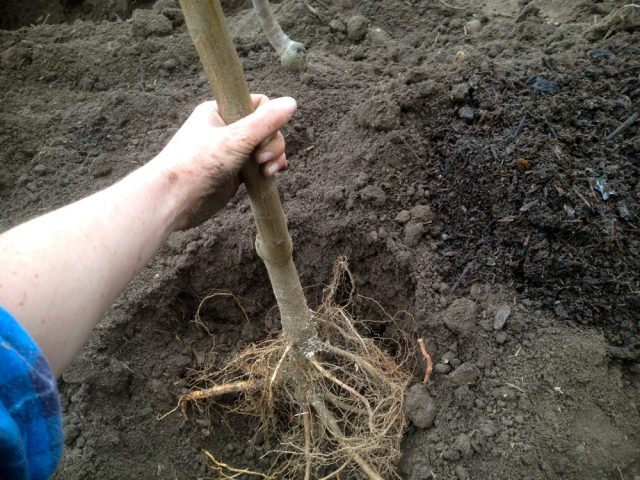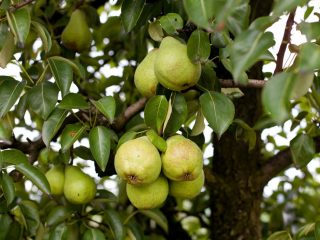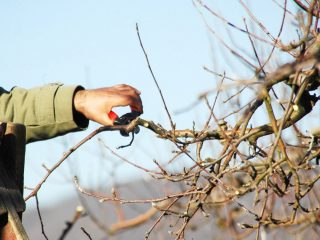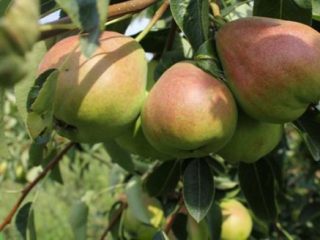Content
The Starkrimson pear was obtained by breeders by cloning the Lyubimitsa Klappa variety. The plant was registered in 1956. And the main difference of the new variety is the externally attractive appearance of the fruit.
Description of Starkrimson pear
The height of an adult tree can reach 5 m, so the pear is classified as a vigorous plant. The crown is wide and has a pyramidal shape.
The Starcrimson pear is densely leafy; leaf blades are dark green or burgundy in color with pointed tips. Flowering is mid-late.
Fruit characteristics
The average weight of one pear varies from 180 to 200 g, but there are fruits weighing up to 300 g. The fruit has an oval-elongated shape and changes color from yellow to red as it ripens.
The pulp of the Starkrimson pear is white in color, sweetish-sour in taste, with a very delicate, nutmeg aroma.
The fruits are widely used in the manufacture of desserts, jams and preserves. Delicious liqueurs and compotes are made from the fruit.
Pros and cons of the Starkrimson pear variety
An objective assessment of the advantages and disadvantages of a plant allows you to choose the best option for your garden. According to the description and photo of the Starkrimson pear variety, it has a decorative appearance, a beautiful wide crown and attractive fruits.
Advantages:
- the tree tolerates drought and low temperatures well;
- ease of care;
- high productivity;
- the presence of immunity to pests and parasites.
The disadvantages of the Starkrimson variety include its tallness and the inability to transport fruits over a long distance.
Optimal growing conditions
In a garden plot, it is recommended to give preference to a place with good lighting: the tree tolerates shade well, but this leads to a decrease in yield.
The variety is recommended to be grown in loose, moist soil with a small clay content. It is important to choose an area protected from the wind.
The Starkrimson pear tolerates moisture deficiency well, but this affects fruiting and resistance to frost.
Planting and caring for the Starkrimson pear
When growing a variety, it is important to consider the climate. In the northern and southern regions, they prefer to transfer seedlings to the soil in the spring. This allows the tree to adapt and take root so as not to be afraid of frost. It is recommended to carry out the procedure from April 20 to April 30.
It is allowed to plant Starkrimson pears in the fall. The optimal time for this is no later than the second half of October.
Landing rules
According to the description of the variety, the Starkrimson pear does not require strict adherence to a specific planting algorithm, therefore they adhere to the general rules:
- the distance from buildings and fences from trees is at least 3 m;
- a hole for a seedling is dug up to 1.2 m deep and up to 80 cm in diameter, the soil is loosened to the depth of a bayonet and 4-5 handfuls of ash are added, everything is spilled with water so that the soil has a creamy consistency;
- The roots of a pear seedling are dipped into the resulting mixture, after which the soil is loosened again and 10 raw eggs are added, mixed and sprinkled with dry soil;
- the treated seedling is placed in a hole, then sprinkled with soil and another 10 eggs are laid around the perimeter, this will provide the plant with the necessary nutrients;
- At the end of the procedure, the soil around the trunk must be mulched with pine needles, sawdust or peat.
Watering and fertilizing
The Starkrimson pear variety is not demanding on soil moisture: the procedure is not carried out during heavy rainfall; in hot months, watering is carried out more often. The norm is 20-30 liters of water per 1 m2 . It is important to loosen the soil in the tree trunk area after moistening the soil.
The timing of fertilizing depends on the planting season of the variety. Spring seedlings are fertilized in the second year after being transferred to the soil. Pears planted in autumn are fed a year after the snow melts.
In spring, nitrogen-containing preparations must be added to the soil. This has a beneficial effect on the process of flowering and fruiting. They use such agents as ammonium or sodium nitrate, urea.They are often produced in granular form, so the product is scattered around the plant and loosened the soil.
Fertilizing in summer has a positive effect on the appearance of fruits and plants. To do this, use potassium and phosphorus fertilizers, which are dissolved in water according to the instructions. The resulting substance is used to irrigate the tree crown in windless morning weather.
Autumn feeding allows the Starkrimson pear to replenish the lack of nutrients and safely withstand low temperatures. The procedure is carried out in September, immediately after harvest. To do this, potassium and phosphorus fertilizers are used, which must be scattered around the trunk and then loosened the soil.
Trimming
The procedure is carried out to form and thin out the crown. Pruning the Starkrimson pear allows the tree to redistribute its forces to fruiting rather than strengthening young shoots.
In spring, the procedure is carried out as follows: the trunk is shortened by ¼, then all cuts are covered with garden varnish.
In autumn, the procedure is carried out from late August to mid-September. It is necessary to remove all affected and dry branches, as well as shoots growing at an angle of 90 °.
Whitewash
Lime performs a protective function: it protects the tree from burns and pests, and allows the plant to better tolerate low temperatures.
The optimal time for whitewashing Starkrimson pears is autumn (October-November). In the spring, the procedure is carried out in February-March.
Whitewashing is carried out in stages:
- Cleaning: Using fabric gloves, clean the trunk of moss, mold and pieces of bark. The contents of the cracks are pulled out using wood chips or other available materials. Before starting the procedure, a cloth is spread around the trunk to remove all debris later.
- Disinfection: the entire cleaned surface, cracks and wounds are treated with specialized products. This allows you to destroy all pathogenic bacteria. Copper or iron sulfate and ash lye are used as disinfectants.
- Treatment: All cracks and wounds must be covered with medicinal preparations. To do this, use garden pitch, specialized pastes and putties.
- Whitewash: For the procedure, prepare a lime solution or purchase ready-made garden paint for trees. Brushes or rollers and a spray bottle are used as tools for whitewashing. The optimal height for applying the product is the standard and 1/3 of the skeletal shoots.
Preparing for winter
The degree of cover depends on the region where the crop is grown. In the northern regions, fabrics, spruce branches and boards are used. In more southern regions, they limit themselves to covering material or refuse insulation.
Preparations for winter begin before the onset of frost.All stands are removed from the Starkrimson pear so that the branches are closer to the soil. Weights are used to press young shoots to the ground. Soil is poured over the branches and covered with snow after precipitation appears.
If possible, young trees and seedlings are wrapped in fabric, and the ground is covered with brushwood.
Pollination
The Starkrimson pear is not capable of pollinating on its own, so it is recommended to plant varieties such as Panna, Forest Beauty, Dessert and Bere Ligel. When choosing a tree, you need to study the features of its planting and care.
Productivity
Fruiting depends on the type of rootstock used. If it is a quince, then the Starkrimson variety begins to produce a harvest 4-5 years from the moment of planting. When using a forest pear for rootstock, the tree bears fruit after 7 years.
Fruits ripen from July to August: the timing is affected by the climate zone. It is recommended to harvest 10-14 days before they are fully ripe, when the fruit is yellow in color. This will preserve its presentation. The collection of pears begins from the lower branches to the upper ones.
The yield ranges from 12 to 35 kg of fruit per tree, the maximum numbers are observed 7-10 years from the moment of planting.
The Starkrimson pear does not tolerate transportation well, so if transportation is necessary, unripe fruits are collected. Given this feature, the variety is not used for commercial purposes; it is grown for personal needs.
To preserve the fruits in their original form, it is necessary to use a ventilated room in which a container with dry sawdust is installed.Damaged fruits rot quickly and should therefore be consumed immediately.
Diseases and pests
The Starcrimson pear can be attacked by bugs, honey beetles, hawthorn caterpillars and itch. To combat them, chemical preparations with pest control properties are used: Karbos, Nitrafen or Fufanon.
The main preventive measures are the timely application of mineral fertilizers and monitoring the condition of the tree.
Scab is a disease to which the Starkrimson pear is immune, but if the rules of care are not followed, there is a high risk of its development.
The disease is characterized by the appearance of dark green and then brown spots on the leaf blades. Gradually, the fungus spreads to the rest of the tree, including the fruits. As the disease progresses, the foliage turns yellow and flies off, and the tree gradually dies. For treatment, fungicidal agents are used: Tridex, Merpan.
The Starkrimson pear may be affected by fruit rot. The disease is characterized by a change in the color of the leaf blades to brown and their gradual drying out. The fruits become lighter in color and are covered with whitish spores.
As a treatment, Bordeaux mixture is used, which is used to irrigate the pear before and after flowering. Affected fruits are removed from the branches and disposed of.
Reviews of Starkrimson pear
Conclusion
Starkrimson pear is a high-yielding variety that has a characteristic feature: red fruits. The tree is tall, but with proper pruning and shaping it does not take up much space and serves as a decorative element in the garden. Proper selection of location on the site and pollinator are the basis for successful cultivation of the variety.














